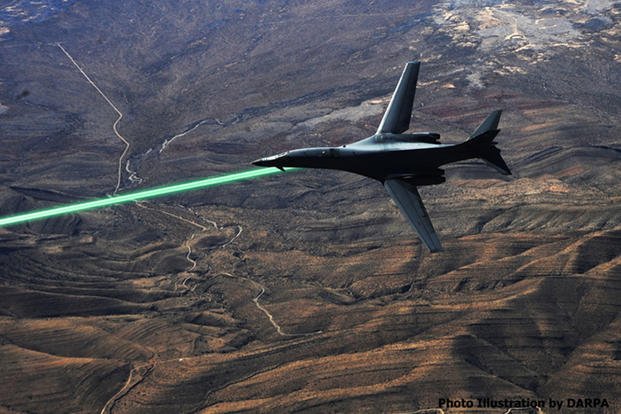If the Pentagon intends to be laser-focused in its goal to improve directed-energy weapons, it has just a few years to decide whether it wants to invest heavily in the new technology, according to the former director of the Missile Defense Agency.
"There are some things that kinetic weapons will not be able to do" now or in the future, said Henry "Trey" Obering, an executive vice president at consulting firm Booz Allen Hamilton who leads the company's directed energy innovation team.
"The big difference between kinetic energy weapons and directed energy is obvious: It's the speed of light, and where would you need a speed-of-light weapon?" he said, pointing out that the need to stop a fast weapon is ubiquitous on the current and future battlefield, including space.
Obering said the Pentagon -- should it get its $700-billion-plus spending boost -- could afford to throw additional resources toward the directed energy fight. It's an investment, much like the one the Pentagon made years ago to smart, laser- or GPS-guided munitions as opposed to dumb bombs that paid off, starting with Operation Desert Storm.
Related content:
- Missile Defense Chief Wants Space-Based Missile-Tracking Sensors Now
- Navy Likely to Be First Service to Field Laser Weapons, Expert Says
- In Tech, US Must Be Where Russia, China Are Not: Air Force Scientist
"Even if we increase [the funding] to $2 [billion] to 3 billion per year, I think you will see dramatic improvements and dramatic advances," said Obering, a former Air Force lieutenant general, fighter pilot and NASA space shuttle engineer, in a recent interview with Military.com.
He explained that directed energy-detection weapons, such as lasers, microwaves or even particle beams, will not be the solution to countering other high-speed weapons but, rather, would act as a complementary enhancement.
Using lasers, "You're tracking and your engagement is almost instantaneous," Obering said. "You can bring down drones efficiently and very effectively" with lasers or high-powered microwaves, he said.
Another potential application is for boost-phase missile defense.
"A speed-of-light weapon like … a laser … would be very effective in the boost phase" before a rocket travels across hundreds of miles, Obering said. This could also apply to adversary hypersonic missiles, he added.
The best place to put those weapons, he posited?
Space.
"You don't have the atmosphere to deal with," he said. "Let's say that you need enough lethality to shoot down a boosting missile in the atmosphere. If you elevate … a laser out of the atmosphere, you can achieve the exact same lethality with about half the power because you don't have to deal with the atmosphere. Your effective range increases in space, and the amount of power that you need decreases.
"I think that that's where this country needs to go. We need to be serious about establishing a space-based capability," Obering said, adding that the technology, with proper funding, could be developed within the next decade.
Last month, Mike Griffin, undersecretary of defense for research and engineering, said the Pentagon plans to boost its investment in the laser technology realm for missile defense over the next few budget cycles.
"You need another factor of three to four to have as space control weapon, a missile defense capability -- space-based, boost-phase or midcourse capability -- with a large directed-energy weapon," Griffin said during a Center for Strategic and International Studies event, as reported by Defense News.
What the Pentagon wants to invest in is high power and increased range -- hundreds of kilometers in range -- to be able to "go after missiles" in their boost phase, Obering said.
"If you look at the range of the laser the Navy put on the USS Ponce, what the Army's doing with the laser on the Stryker vehicle … those applications would be relatively low-powered, tens of kilowatts and relatively short ranges," he said.
They merely scratch the surface.
"There's a lot of technology that has [advanced] in the solid-state, fiber or hybrid lasers … where the efficiency of the diodes has dramatically increased. We've also made tremendous strides in new materials and materials science," Obering said, referring to lightweight products that are as strong as titanium.
So to improve on the capability, the Pentagon likely will analyze a multitude of ingredients for investment: laser power scaling, or increasing its output power; beam quality, or intensity and coherence of the beam; and tailored size, weight and power input requirements, Obering said.
If done correctly, "you can kill multiple missiles with a single laser," he said.
"There are some applications in which you don't want your adversary to know that you're there, and you want to be able to disable certain capabilities to prevent from escaping … or to de-escalate … or a number of attributes that you want to take advantage of," he said.
But the application doesn't need to be super sophisticated: The technology could be used at checkpoints in hot war zones where a vehicle-borne improvised explosive device could attack a base.
"Using high-powered microwave, you could actually shut those vehicles down," he said.
Adversaries such as Russia or China also are looking for more advanced ways of using lasers, Obering said. "We have real threats, existential threats that could be on par with us. And we haven't had that since the height of the Cold War.”
-- Oriana Pawlyk can be reached at oriana.pawlyk@military.com. Follow her on Twitter at @Oriana0214.










